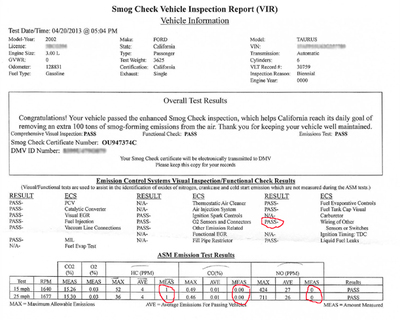Screaming Mad About High Gas Prices? Use More Ethanol!
 Screaming Mad Howard Beale (NETWORK) |
Save 10%, 20%, 30% and MORE Immediately
 Marc Rauch |
Author of THE ETHANOL PAPERS
Exec. Vice President/Co-Publisher
THE AUTO CHANNEL
Are you screaming mad about high gasoline prices yet? You should be. Particularly because there's no reason for the prices to be so high ...and ESPECIALLY because you can do something about it.
The good news is that you don't have to run to your window to scream that you're not going to take ridiculously high gasoline prices any more, you just have to put more ethanol in your fuel tank.
Every gasoline-powered internal combustion vehicle on the road today...anywhere in the world...can safely, efficiently, and economically use fuel that contains more than E10 (10% ethanol). The vehicle doesn't have to be a flex fuel vehicle, or have any modifications, or any added devices to use the fuel. The only thing you will need is one or more filling station that sells E85.
Using more ethanol will save you money because E85 is less expensive than E10 and usually much, much less expensive than E0 (ethanol-free gasoline). You will get comparable MPG to E10 or E0, and you may even get more miles per gallon.
This is not a trick. It's not an optical illusion, or delusion, or confusion.
CONSIDER THIS
From the 1920s through the 1970s, ethanol-gasoline blends were marketed in Great Britain by Standard Oil/ESSO and Cities Service Gasoline. Standard Oil, now known as ExxonMobil is the world's largest gasoline company. Cities Service Gasoline is more commonly known as CITGO, and it had been a large American owned company. The ethanol-gasoline blends were called POWER ALCOHOL and KOOL MOTOR, respectively, and the blends ranged from E10 to E30. Power Alcohol and KOOL MOTOR were promoted as being cleaner, safer, more powerful, healthier, and less expensive than E0 gasoline. In the United States and other countries, Standard Oil and Cities Service invented lies about ethanol. These are the lies that most people are familiar with today. Can I prove this? Of course, CLICK and read this report I wrote in 2017:
The Hypocrisy of Big Oil
This means that all the great British and European cars of the '20s, '30s, '40s, '50s, '60s, and '70s could run on ethanol-gasoline blends with NO PROBLEMS, no modifications, and no special devices. And American cars that were used in the UK were also able to run on ethanol-gasoline blends with no problems, no modifications, and no special devices. Therefore, all older vehicles that people collect and cherish today can still run on ethanol-gasoline blends.
Beginning in 1978, Brazil mandated the use of E15 ethanol-gasoline fuel. As the years passed by, Brazil increased the level of ethanol in their mandated blended fuel. A few years ago, it was increased from E25 to E27. Brazil is a large, sophisticated country. It has a population equal to the combined populations of Germany, Great Britain, and France. Brazil has about 50 million vehicles on the road, and the profile of the vehicles are the same that are found in any other country in the world: classics, older, newer, and new vehicles. Brazil has all the same vehicles that are in America, Canada, England, Spain, France, Japan, Australia, etc., etc. They are not specially modified to operate in Brazil. When a car leaves a factory in Mexico or Japan or South Korea, it can be sent to America or Brazil (or any other country).
Simply put, if a non-flex fuel 1989 Ford Mustang or a non-flex fuel 2022 Ford Mustang can safely, efficiently, and economically run on E27 on the streets of Rio de Janeiro, it can do so on any street anywhere else in the world!
How do I know this for sure? Because I have driven dozens of non-flex fuel cars on ethanol-gasoline blends that are significantly higher than E10 with no problems, no modifications, and no special devices!
In fact, several years ago, I purchased a used non-flex fuel 2002 Ford Taurus specifically to conduct a long term test of using higher blend levels than E10. I was able to do this by "splashing blending." This means I would first pump a desired amount of E85 into the tank, then fill the rest of the way with regular E10. The car had an 18 gallon fuel tank. On any given occasion, I would pump in 6, 8, 10, 12 gallons of E85 fuel. This would give me approximate blend levels of E40 to E60. However, if I needed fuel, and was not near a service station that offered E85, I would only pump in E10. Therefore, I might be running on as low as E10 to E20, depending upon how much higher blend was already in the tank. I found that I attained peak MPG efficiency at around E40. When the blend level was E50 or above, the red check-engine light would illuminate on my dashboard, but it would go off when the ethanol level would be under E50. The engine itself ran the same at all these blend levels.
The single most noteworthy experience I had with my 2002 non-flex fuel Ford Taurus was the first time I took the vehicle for a smog test after using high ethanol-gasoline blends for about two years. The measured PPM results were an astounding "0" for CO (carbon monoxide), "0" for NO (nitrogen oxide), and "1" for HC (hydrocarbon). In other words, the high use of ethanol fuel made my car super clean. If the general public followed my example all future emissions' goals would be met today, not in 2030 or 2040...right now.
RECENT EXPERIENCES AGAIN PROVE THE ECONOMY & EFFICIENCY OF HIGHER ETHANOL-GASOLINE BLENDS
In late June, my wife and I drove from Northern California to San Diego, and back, to attend graduation at the Marine training base. The drive is about 530 miles each way. We drove a non-flex fuel 2021 Nissan Altima. Driving down we filled up on E10. We made it all the way on one tank full, averaging 35 miles per gallon of fuel.
Driving home, we filled the 16.2 gallon tank with 8 gallons of E85, and topped it off with E10. We encountered more traffic on the return trip (same highway route), with some bumper-to-bumper traffic around Anaheim and then again near Stockton. We made it all the way home on one tank, getting the same 35 miles per gallon of fuel (it would have been an effective blend of about E40).
The cost of the E85 was $1.30 less per gallon than the E10 (E85 was $3.19 per gallon, E10 was $4.49 per gallon). I saved $10.40 on the fill-up, nearly 30% less than what the E10 would have cost. If I had splash blended E40 for the drive there, as well as back, I would have saved almost $21 total.
Last weekend, I drove from Sacramento to Watsonville to attend a birthday celebration for David Blume. In my opinion, Dave is probably the single most knowledgeable guy on ethanol fuel in the world, and he's the author of "Alcohol Can Be A Gas." So it was fitting that I use the trip as an ethanol fuel experiment.
The drive was slightly more than 170 miles each way. I drove a non-flex fuel 2021 Honda Civic with a 12.4 gallon tank. Traffic was roughly the same in both directions: some bumper-to-bumper, and lots of open freeway speeds. Travel time was 4 hours to, and 4 hours from. Outbound the car was filled with E10. According to the computer readout on the dashboard, I averaged 35.8 miles per gallon.
Coming home, I replaced the used E10 with 6 gallons of E85. This gave me an effective ethanol-gasoline blend of about E46. According to the computer readout I averaged 36.2 miles per gallon on E46. So, I achieved slightly better mileage with the higher ethanol-gasoline blend.
When I topped the tank off with the E85, I paid just $3.49 per gallon instead of the E10 price of $4.89, thereby saving $1.40 on each gallon. Multiplying 6 gallons times $1.40 means I saved $8.40 on the return trip. If I had used an E46 blend in both directions I would have saved an additional $8.40; a total saving of $16.80 for a long one-day drive.
I recognize that saving $16 or $21 is not a really big deal, but $16 or $21 in my pocket is a whole lot better than being in the pocket of the oil industry. And if I saved this much 3 or 4 times per month, it would pay for a pretty nice dinner for my wife and I, or a couple of big bags of expensive food for my two big dogs.
More importantly, with a very minor, low-cost computer software update on these two non-flex fuel cars (the Nissan Altima and the Honda Civic), they could use up to E85.
Projecting the savings out to using E85, not just E40 splash blends, the savings would double. Then, my wife and I (or you and your spouse) could have an extra two dinners out every month (that's 24 paid dinners in a year, or 12 dinners out plus the 24 big bags of dog food)!
But that's not the end of the story, because if everyone could experience this kind of savings, it might help to cut some of the inflation we've all been subjected to recently. Perhaps it'll help bring down the cost on everyday groceries, clothing, and other essentials. Sources say that the average American family spends a little over $400 per month of groceries1. If we could all save 25% per month, that would be pretty good. Another $100 per month in our pockets is better than in someone else's. At least it's something positive, something in the right direction. Something happy to scream about for a change!
1 Average Monthy Grocery Expenditures
NOTE ABOUT VEHICLE WARRANTIES
-
Although most new vehicles warranties now cover E15, the manufacturers warn against the use of ethanol-gasoline blends higher than E15, even though they may sell the exact same vehicles in Brazil where the warranties cover E27.
If you're in a country that allows manufacturers to arbitrarily limit warranties to just E10 or E15 (this includes the U.S.), and you're concerned that using higher ethanol-gasoline blends will void the warranty, then DO NOT
follow the suggestions that I've made above. The use of the higher blends will not harm your vehicle, but there's no reason to give anyone the excuse to void your warranty. Wait until after the warranty expires, then have at it!
FOR MORE INFORMATION PROVING THE ECONOMY & EFFICIENCY OF HIGHER ETHANOL-GASOLINE BLENDS, SEE:
-
“As a power producer, alcohol is about equal to gasoline…There is far more safety in the use of alcohol than in the use of gasoline…a fire produced by alcohol is readily put out by water…(whereas) water
only spreads and increases the danger from a gasoline fire. Cleanliness is another attractive feature in the use of alcohol (ethanol). Cylinders and valves do not get clogged by the left-over products of
(gasoline) combustion. Odors arising from (ethanol) are scarcely perceptible and not unpleasant.” (page 60)
“Three Years ago the increase in cost of gasoline compelled us to look for a suitable substitute. I went over to Germany to visit our parent house and study the means which had been adopted to procure a cheap and effective power producer. I found that denatured alcohol (ethanol) was very largely used in internal combustion engines. I had occasion to take part in several shop test made with these alcohol engines… The results we obtained showed that out of an engine of a given size…we got on average 20% more power than out of the same size engine operated on gasoline.” (page 96)
“Other and more scientific tests were made at the same time. I remember one test…when the exhaust gases were analyzed…the object being to determine…the degree to which atmospheric air would be contaminated…The results showed that an alcohol (powered) engine produced about 20% less of obnoxious constituents than the exhaust gases from a gasoline (powered) engine.” (page 97)
“I have also examined the interior portions of alcohol (powered) engines that have been in continuous use for three years, and have found them to be in good working order, except such wear as necessarily takes place in all internal combustion engines.” (page 99)
“Notwithstanding the fact that the heating value of alcohol, or the number of heat units contained (BTU value), is much less than in gasoline, it is found by actual experiment that a gallon of alcohol will
develop substantially the same power in an internal combustion engine as a gallon of gasoline. This is owing to the superior efficiency of operation when alcohol is used.” (page 107)
-
“By using alcohol in an alcohol engine with a high degree of compression…the fuel-consumption rate in gallons per horsepower per hour can be reduced to practically the same as the rate of consumption of
gasoline for a gasoline engine of the same size and speed.” (page 6)
“An alcohol engine with the maximum degree of compression for alcohol will have an available horsepower 30 per cent greater than a gasoline engine of the same cylinder size, stroke, and speed..” (page 7)
“Alcohol has many advantages over gasoline or kerosene as a fuel. The exhaust from an alcohol engine is never clouded with a black or grayish smoke, as is the exhaust of a gasoline or kerosene engine …The odors of denatured alcohol and the exhaust gases from an alcohol engine are also not likely to be as obnoxious as the odor of gasoline and its products of combustion.” (page 36)
• Fuel Economy and Power Generation of 30% Ethanol (E30)
• Effects of High-Octane Ethanol Blends
• Study Finds Certain Ethanol Blends Can Provide Better Fuel Economy Than Gasoline
• The Effect of Ethanol-Gasoline Blends - University of Nottingham...
• The Effect of Ethanol-Gasoline Blends
• High performance Wayne State ethanol car wins 1998 Ethanol Vehicle Challenge
• Freedom of choice: E20 ethanol blends take the value crown from gasoline, E10
• ACE Optimal Ethanol Blend Level Study
• Seven Year Hands-On Study Proves Mid-Level Ethanol Blend's Superiority and Benefits



